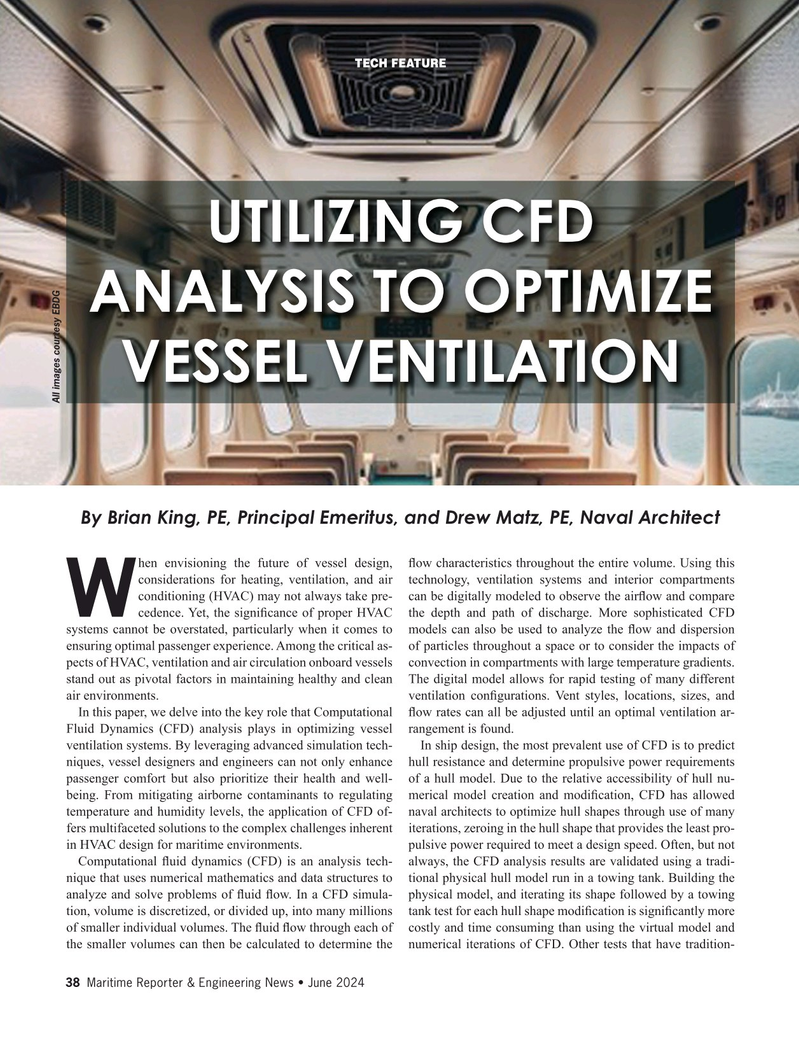
Page 38: of Maritime Reporter Magazine (June 2024)
Read this page in Pdf, Flash or Html5 edition of June 2024 Maritime Reporter Magazine
TECH FEATURE
UTILIZING CFD
ANALYSIS TO OPTIMIZE
VESSEL VENTILATION
All images courtesy EBDG
By Brian King, PE, Principal Emeritus, and Drew Matz, PE, Naval Architect hen envisioning the future of vessel design, fow characteristics throughout the entire volume. Using this considerations for heating, ventilation, and air technology, ventilation systems and interior compartments conditioning (HVAC) may not always take pre- can be digitally modeled to observe the airfow and compare
Wcedence. Yet, the signifcance of proper HVAC the depth and path of discharge. More sophisticated CFD systems cannot be overstated, particularly when it comes to models can also be used to analyze the fow and dispersion ensuring optimal passenger experience. Among the critical as- of particles throughout a space or to consider the impacts of pects of HVAC, ventilation and air circulation onboard vessels convection in compartments with large temperature gradients. stand out as pivotal factors in maintaining healthy and clean The digital model allows for rapid testing of many different air environments. ventilation confgurations. Vent styles, locations, sizes, and
In this paper, we delve into the key role that Computational fow rates can all be adjusted until an optimal ventilation ar-
Fluid Dynamics (CFD) analysis plays in optimizing vessel rangement is found.
ventilation systems. By leveraging advanced simulation tech- In ship design, the most prevalent use of CFD is to predict niques, vessel designers and engineers can not only enhance hull resistance and determine propulsive power requirements passenger comfort but also prioritize their health and well- of a hull model. Due to the relative accessibility of hull nu- being. From mitigating airborne contaminants to regulating merical model creation and modifcation, CFD has allowed temperature and humidity levels, the application of CFD of- naval architects to optimize hull shapes through use of many fers multifaceted solutions to the complex challenges inherent iterations, zeroing in the hull shape that provides the least pro- in HVAC design for maritime environments. pulsive power required to meet a design speed. Often, but not
Computational fuid dynamics (CFD) is an analysis tech- always, the CFD analysis results are validated using a tradi- nique that uses numerical mathematics and data structures to tional physical hull model run in a towing tank. Building the analyze and solve problems of fuid fow. In a CFD simula- physical model, and iterating its shape followed by a towing tion, volume is discretized, or divided up, into many millions tank test for each hull shape modifcation is signifcantly more of smaller individual volumes. The fuid fow through each of costly and time consuming than using the virtual model and the smaller volumes can then be calculated to determine the numerical iterations of CFD. Other tests that have tradition- 38 Maritime Reporter & Engineering News • June 2024

 37
37

 39
39
